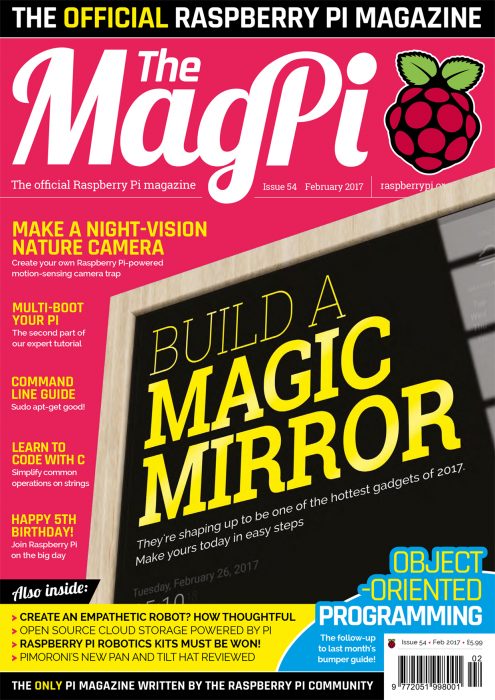
- #MAGIC MIRROR RASPBERRY PI BUILD SUPPLIES INSTALL#
- #MAGIC MIRROR RASPBERRY PI BUILD SUPPLIES UPDATE#
- #MAGIC MIRROR RASPBERRY PI BUILD SUPPLIES SOFTWARE#
- #MAGIC MIRROR RASPBERRY PI BUILD SUPPLIES PC#
- #MAGIC MIRROR RASPBERRY PI BUILD SUPPLIES DOWNLOAD#
I used a stud finder to find where my studs were located near the area in which I wanted to mount my mirror.One of the slickest-looking examples was just posted earlier this month by Google employee Max Braun. Visit to learn more.įourth Step: Mount the Mirror on the Wall The Magic Mirror platform is very modular and expandable, so it is very easy to get started adding on modules to the platform.
#MAGIC MIRROR RASPBERRY PI BUILD SUPPLIES INSTALL#
Install the unclutter utility: sudo apt-get install unclutter Add the following lines to the config file: display_rotate=1avoid_warnings=1 edit /boot/config.txt: sudo nano /boot/config.txtĢ. Rotate the screen (if you have a portrait oriented mirror):ġ. Just copy/type them into the terminal like before. Here are some additional settings you can use if your smart mirror project needs them. You will have to edit your config file to set up weather, calendar and other stuff.Īdditional settings for best experience (optional) If it doesn’t allow you to save, try opening the file again without the “sudo” command. If all went well, Magic Mirror should start up after about 1-2 minutes. Press ctrl+x, save the file and reboot your Pi. Keep the screen from going to sleep: sudo nano ~/.config/lxsession/LXDE/autostartĪdd the following lines to that file: s s -dpms Rotate the display to portrait mode if your mirror isn’t landscape: sudo nano /boot/config.txtĪdd the following line to the file: display_rotate=1 Now, reboot your Pi by typing in sudo reboot Now start up Magic Mirror and make it start up on boot: pm2 start mm.sh Make your shiny new script executable by typing in: chmod +x mm.sh When the text editor has opened, add this to the mm.sh file: cd ~/MagicMirrorDISPLAY=:0Įxit the editor by pressing ctrl+x and type in y to save the file.

The lower line basically means, “open up a file called mm.sh in the nano text editor.” Open up the built-in text editor on the Pi by typing in: cd ~nano mm.sh We want Magic Mirror to start up automatically, so type in the following command: pm2 startupĪ different command will appear. Make Magic Mirror automatically start when the Pi boots up Now you’re ready to start up your Magic Mirror, so type in the following: cd ~/MagicMirrorħ. type in y and press enter to confirm, since we want to make the mirror start up automatically if the power goes out, for example. If you get an error that says “Unable to install dependencies!” you have to install an older version of Electron: sudo npm install -g installer will ask if you would like to use pm2 to automatically boot up into the Magic Mirror dashboard. You just have to type in a single command to install it.Ĭopy and paste the following into the Terminal: bash -c "$(curl -sL )" The MM² platform is very easy to install. Install Magic Mirror on your Raspberry Pi You will be asked to put in a password, which on a Raspberry Pi is “raspberry” by default.Ħ.
#MAGIC MIRROR RASPBERRY PI BUILD SUPPLIES PC#
Go to Preferences > Raspberry Pi > Configuration > Interfaces and enable SSH.Īfter you’ve enabled SSH, restart your Raspberry Pi.Īfter the Pi has booted up, open up your PC computer’s terminal ( Terminal on a Mac or Command Prompt in Windows) and type in the following command: ssh replace the part after the sign with your Pi’s IP address. That way, you can send commands to your Pi from your PC, which is handy if it’s hanging up on the wall behind a mirror!įirst you have to enable SSH on your Pi. SSH (Secure shell) is a network protocol that’s used to connect to computers remotely. Enable SSH on your Pi and connect remotely You’ll see some text appear, and your Pi’s IP address is next to “inet addr”. When in the terminal, type in the command: ifconfig Move your mouse to the top left corner, click Menu > Accessories > Terminal To do this, you have to open up your Pi’s terminal. In the top right corner of your screen, you should see a network icon that looks like two computers with an X.
#MAGIC MIRROR RASPBERRY PI BUILD SUPPLIES UPDATE#
Your Pi needs the internet to update stuff that it shows you, so you have to connect to a Wifi network. After booting up, you will see the Raspbian desktop screen. You’ll need to connect the Pi to power and to a monitor, as well as hooking up a mouse and keyboard.

Unmount the SD card from your PC and insert it into your Pi. Review your selections and click ‘Flash!’ to begin writing data to the SD card.Select the SD card you wish to write your image to.Open Etcher and select the Raspbian Stretch image you downloaded.

#MAGIC MIRROR RASPBERRY PI BUILD SUPPLIES DOWNLOAD#
#MAGIC MIRROR RASPBERRY PI BUILD SUPPLIES SOFTWARE#
Like I said in the video, the software part of this project is a bit command line intensive. I cut a small notch in the frame so I could easily run the wire though, Finally, I cut out and hot glued a black foam poster board to act as an opaque layer and mounted a raspberry pi and all of the power equipment inside the frame.


 0 kommentar(er)
0 kommentar(er)
